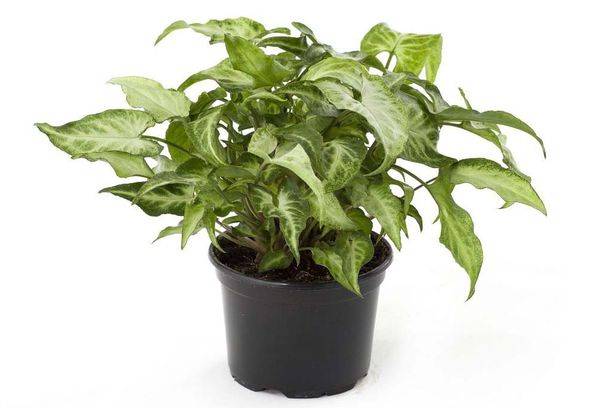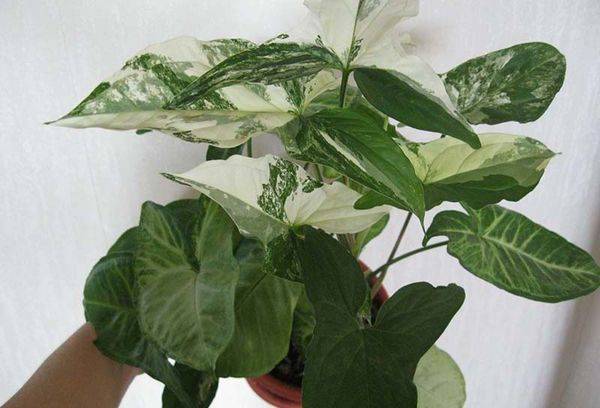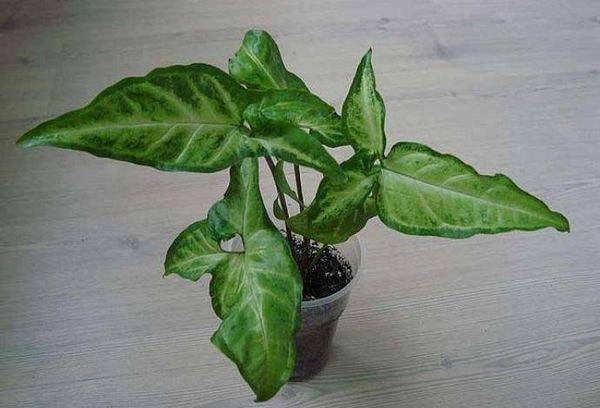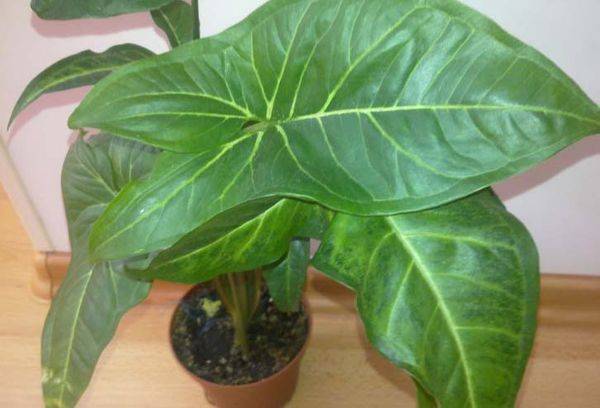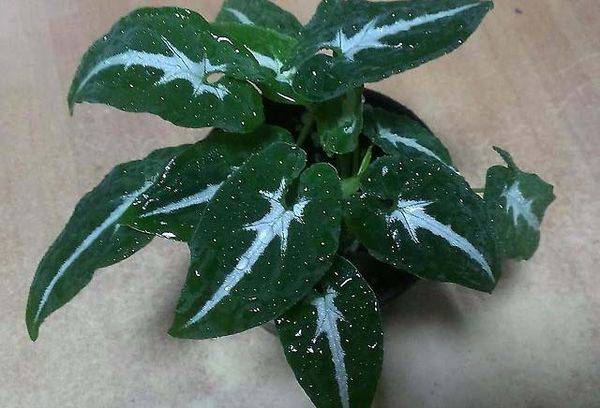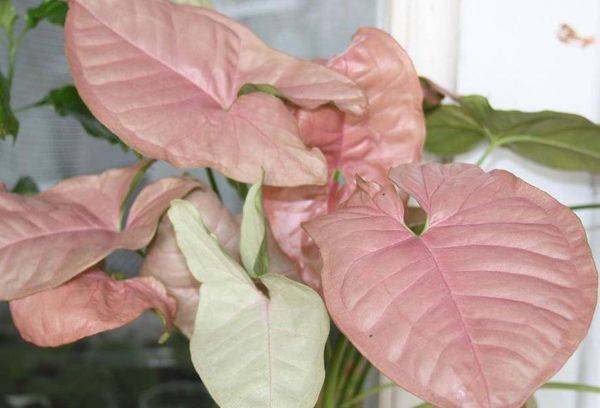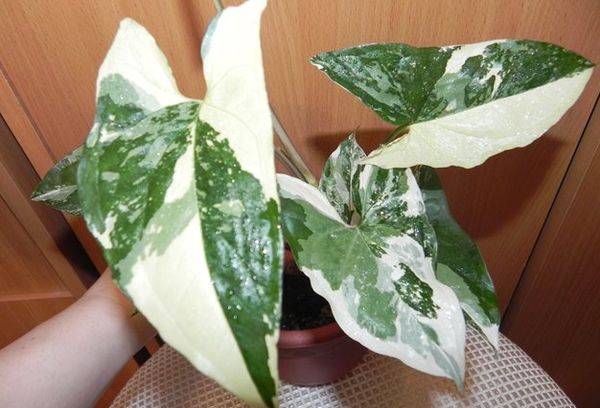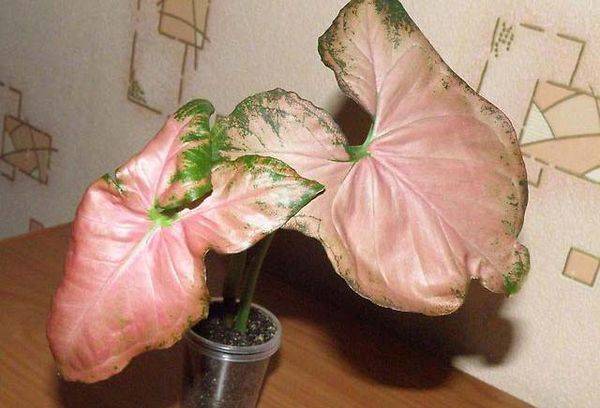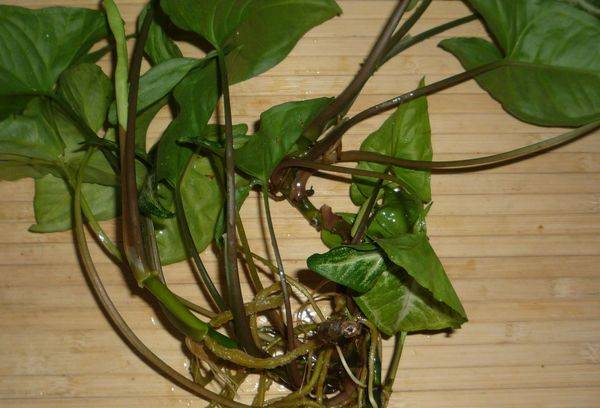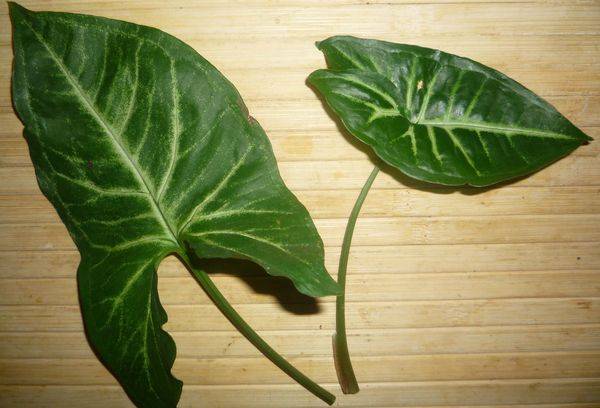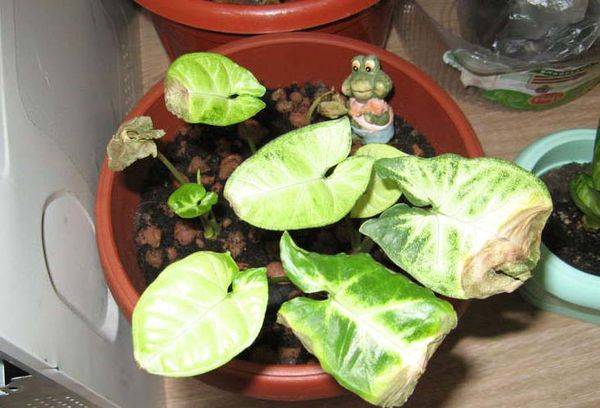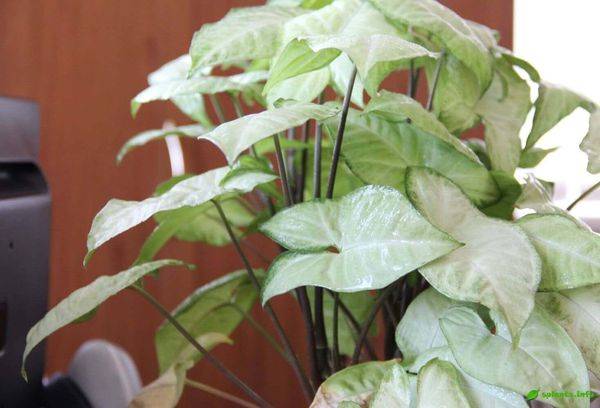How to care for syngonium (tropical vine) at home
Content:
Among flower growers, singonium - a liana flower with rich green leaves on long petioles became famous for its decorative and unpretentiousness. Caring for syngonium is a fascinating activity. This plant refreshes the interior in every sense: in the room where the syngonium grows, it is always easy to breathe, and its green foliage adorns the space. How to grow a vine at home, are there any difficulties in growing? What is interesting plant and why you should pay attention to it - read in this publication.
Description, features
Syngonium is a perennial herbaceous plant. This is a fast-growing vine, the stem of which clings to the support with aerial roots. In the absence of support, the syngonium spreads beautifully on the ground. The average shoot height is 1.2-2 m, in the wild there are lianas up to 20 m in length.
Arrow-shaped leaves grow from convex nodes throughout the stem. Their color depends on the variety of syngonium. In a year, the plant forms 6-7 new leaves. At a young age, the sheet plate remains intact, and in old samples it is divided into several parts. The surface of the leaf can be smooth or velvety, decorated with convex veins in the center and edges.
Syngonium belongs to the Aroid family. In total, there are up to 33 species of syngonium. The native land of the plant is Central and South America; it grows in tropical forests, climbing into the light along the powerful trunks of neighboring trees. The bloom of syngonium, unfortunately, is observed only in the natural habitat. When grown at home, the absence of flowering is offset by the beauty of the leaves.
Species and varieties
Of the variety of species, only a few are suitable for home gardening.
- Syngonium auricular, or ear-shaped (Syngonium auritum) - evergreen liana. In the internodes on adult stems of the plant, aerial roots form. On the petioles are large glossy leaves of saturated green color. Petioles are no more than 40 cm long. Young leaves have an oval shape and two ears per petiole. Old leaves have three large lobes and two small ones.
- Syngonium pectophyllum (Syngonium podophyllum) in indoor conditions it grows to 1.5, sometimes 2 m. It has large glossy leaves of a light green hue (some varieties have yellow and pink spots and veins). With age, the leaves transform into palmate, up to 11 lobes on each plate. Some syngoniums retain the swept shape of the leaf throughout life. Interesting varieties: White Butterfly (bushy), Pixie (dwarf liana), Neon (pink surface of the leaf), Panda (light spots on the leaf plate).
- Syndonium Wendland (Syngonium wendlandii) - shrub liana of medium height. Large leaves on thick petioles look like an arrow with three tips. The surface of the leaf plate is green, velvety, the central part is painted in light green.
- Syngonium Regina red (Regina Red) - characteristic pink color of leaves.
- Syngonium Imperial White - a liana whose leaves grow with large white spots, sometimes completely white. To maintain an unusual color helps a high nitrogen content in the soil. But beauty requires sacrifice: such leaves quickly die off, and propagation of the variety is problematic.
Care
Growing syngonium at home is not at all difficult. A resident of the tropics needs minimal care.First of all, he will need diffused lighting, since in the natural environment it is obscured by tall trees. Window sills facing east or west are best. Varieties of syngonium with dark green leaves grow comfortably in partial shade, and for brightly colored species you need more light, otherwise the leaves grow dull and become ordinary green. In winter, with a lack of light, the flower often dims, so provide it with a long daylight using an artificial lamp.
The plant withstands temperature extremes, which is unusual given its tropical origin. Although the flower will suffer a drop in temperature to +10, it is still better to observe optimal conditions: up to +18 in winter and up to +24 in summer. This is especially true for variegated varieties, they can die from a sharp change in temperature. What Syngonium really does not like is drafts: try to protect it from direct air currents.
Watering and humidity rules:
- The plant is hygrophilous. Each subsequent watering is carried out as the topsoil dries. It is advisable not to allow drying deeper than 2-3 cm.
- Drying the substrate completely is dangerous: the plant may wither away.
- It is advisable to defend water for irrigation for 2-3 days. Water temperature - room temperature or 2-3 degrees warmer.
- The plant needs spraying, especially in winter, when the air is dry due to the operation of the heating system. One spray per day is enough.
- Once a month, it is allowed to bathe the plant under a warm shower.
- Wipe the leaves of the syngonium periodically with a damp cloth to protect against dust.
Tip
It is better to wipe the leaves in the summer, spraying in the winter.
Syngonium will not refuse to feed, it is done in spring and summer. Suitable liquid mineral fertilizers for decorative and deciduous plants with a low calcium content. Top dressing is applied once every 2-3 weeks at a certain distance from the stems. In winter, you do not need to feed a flower.
Transfer
Transplantation to young plants is required annually. Adult vines are enough to change their place of residence once every 2-3 years. A sign that the vines need a transplant - the roots begin to peek out of the drainage holes. The transplant procedure is carried out in the spring. The soil for syngonium should be:
- neutral or slightly acidic,
- loose
- nutritious.
Ready mixes are available for sale. For self-production of the substrate, take:
- sheet earth - 2 parts;
- turf land - 2 parts;
- peat - 2 parts;
- sand - 1 part.
A transplant pot is taken a little more than before. The presence of drainage holes is mandatory, as is the drainage layer. Therefore, pour a fresh drainage layer at the bottom of the tank: expanded clay, river pebbles, gravel, gravel or pieces of foam. Layer thickness - 1-3 cm.
The roots are straightened, the plant is placed in a pot and covered with a substrate. Earth needs to be slightly crushed. The transplant is carried out by the method of transshipment, that is, without clearing the lump of earth from the roots. This allows you to keep thin roots intact.
Breeding
Reproduction at home is carried out only in a vegetative way:
- apical cuttings,
- aerial cuttings
- parts of the escape.
Transplant shoots are taken only if there are two or more buds on them, regardless of the time of year. However, spring and summer seedlings take root much better. The handle is neatly separated from the main shoot with a sharp knife. Then you need to root it. There are two ways to do this:
- In warm water you need to dissolve a tablet of activated carbon. If desired, a growth stimulator is added. The roots of the stalk of the syngonium appear rather quickly. When the stem is rooted, it is planted in a moist substrate. It is necessary to create greenhouse conditions for the young plant to take root. To do this, cover the pot with a glass or plastic bag. Do not forget to air the plant from time to time.
- A cut of the cut is treated with a growth stimulator, then the young seedling is sent directly to the pot with the substrate. At the time of rooting, the pot must be covered with a film or bag. This will reduce the evaporation of moisture. Planting young syngoniums is recommended at a temperature of about +25. When the stalk is rooted, the shelter is removed and the seedling is grown as an adult plant.
Growing problems, diseases
Syngonium has good immunity, but with improper care it is often exposed to pests. What to fear when growing:
- Aphid attacks. To get rid of this insect is quite simple: the plant is completely wiped with a soapy solution. If there are several colors in the home collection, then the rest are also treated as a preventative measure. If necessary, the procedure is repeated after a few days. If the aphid does not leave the syngonium in any way, then insecticides are used. Be careful when using chemicals, always follow the instructions and use protective gloves.
- The insidious scale shield easily settles on both the outer and inner surfaces of the leaf. Therefore, you should often inspect the plant from all sides. If a parasite is detected, it is destroyed by an insecticide.
- A sign that thrips is embroiled in a plant are white dots on a leaf plate. Apply an insecticide.
- The spider mite is destroyed like aphids. Only re-treatment should be carried out after 2 days.
Improper care with a high probability provokes the following diseases of a tropical plant:
- The leaves turn yellow. Inspect the plant for rot. If rot is not detected, then the reason is a lack of nutrients.
- The tips of the leaves dry out - a clear sign of insufficient humidity. The problem is solved by spraying or installing a humidifier. A successful move is to place a pot of liana near the aquarium.
- The leaves turn yellow and fade, the roots rot - you waterlogged the substrate. The plant needs a transplant, removal of dead roots and their processing with potassium permanganate (disinfection).
- The roots dry and die. It is necessary to cut off the dead areas, place the roots in the water for a while, then plant the syngonium in a new substrate. The drainage layer must also be fresh.
- Leaves lost color saturation and luster. This is due to excess moisture in the air and soil.
- Young leaves do not grow as large as old. Increase the amount of light, do not forget about fertilizing.
- If variegated varieties lose color or become ordinary green, then you need to increase the amount of light.
Precautions and Tips
This must be known when growing syngonium:
- If the leaf membrane is damaged, poisonous milky juice is released, which causes irritation of the skin and mucous membranes. Always wear protective gloves. Close liana access to pets and children. Thanks to poisonous juice, the plant is rarely attacked by pests.
- On a bright sunny day, it is better to clean the pot 1.5-2 m from the window so that the flower does not get burned.
- The shower for the plant should not be too cold or too hot.
- Think in advance support for the creeper. During planting, you can install the support directly into the flowerpot: this will help to avoid unnecessary difficulties in transporting the vine.
- purityis.decorexpro.com/en/ magazine does not recommend placing syngonium near vents and batteries.
- As for the formation of the bush, along with the installation of the support, pinching of the upper shoots is applied (above 6-7 leaves). So the plant will be more bushy. Young lateral processes after pinching sometimes appear even on the old shoot. Do not be afraid to shorten too long shoots, syngonium tolerates pruning well.
- Syngonium will grow without support. Set the pots at a low height so that the creepers hang freely.
- To get a lush shoot, plant 2 or 3 cuttings in one pot.
What is useful flower
Around the syngonium there are many superstitions, some of which directly contradict each other. Popular signs say the following:
- If you put syngonium in the house where the sick person lives, then the disease will recede. The plant is able to put on its feet those who suffer from pathologies that are incurable, according to official medicine.
- According to the horoscope, the syngonium belongs to Virgo. Its main role in human health is a beneficial effect on the gastrointestinal tract.
- Syngonium is a good helper in the fight against bad habits. The plant strengthens the character of its master.
- Liana promotes good physical and mental development. With its help, complexes associated with education are overcome. A person begins to be interested in self-development, broadens his horizons, is not afraid to express his own opinion.
- The plant helps to "become easier." People with a heavy character, skeptics and nerds will benefit from caring for syngonium.
- If you put a pot of liana in the bedroom, it will provide a quiet sleep without nightmares. Another property of the flower: it helps not to focus on unpleasant emotions.
- The controversial property of syngonium: in a house where a plant lives, a woman does not get along with a man. However, according to many observations, in happy families, the syngonium occupies an honorable place on the windowsill.
- Cultivation of syngonium will be useful in a house where there is a person who does not accept changes and who loves everything outdated. The plant will help people who have lost interest in progress and sigh about a beautiful past.
To believe folk fiction or not to believe is everyone's personal business. What is really useful syngonium, is the ability to absorb the vapor of hazardous substances - formaldehyde, xylene and others. The flower saturates the room with oxygen and normalizes air humidity. A plant that carries not only a decorative function, but also a healing one, will be a worthy inhabitant of your apartment.
